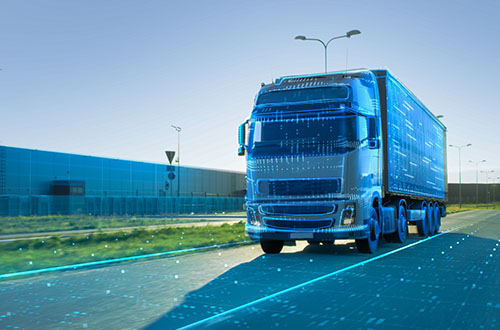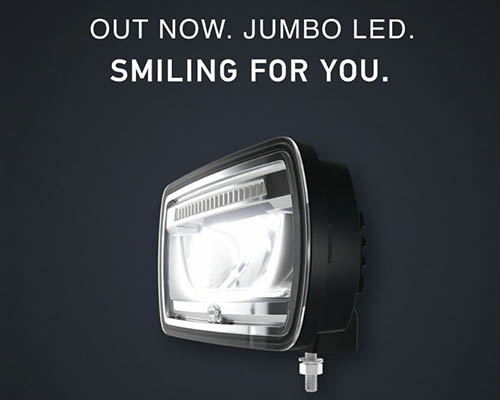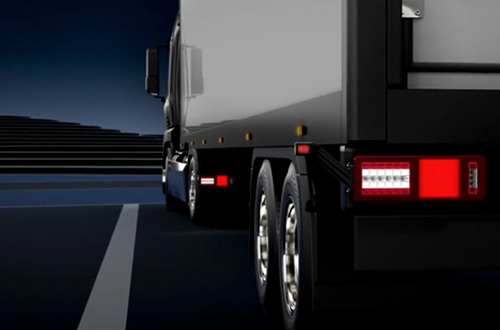
The heavy gang – a real live wire
02-08-2021Electrically powered trucks have indeed been on the road for a long time
Reducing carbon dioxide emissions in freight transport (decarbonisation) is considered to be one of the biggest challenges for the manufacturers of commercial vehicles. In addition to efforts attempting to further reduce CO2 emissions by means of appropriate exhaust gas purification systems, these companies are closely following the development of battery-electric powered trucks (BEV=Battery Electric Vehicles) that are suitable for short and medium-distance travel. As a kind of flanking measure, truck manufacturers are also relying on the fuel cell designed for FCEVs (fuel cell electric vehicles) so as to cover longer distances emission-free. The German Federal Government alone is funding 62 large-scale hydrogen projects in Germany by providing around eight billion euros. Here we have an overview for you.
Fully charged on the road
An e-truck (BEV) with a loaded box or trailer is too heavy, the range of the vehicles too short, the dependence on charging options too high. In fact, battery-electric powered trucks on a long haul and in international heavy goods traffic are difficult to imagine. However, as far as short-haul and medium-haul are concerned, such prejudices have long been regarded as antiquated. Today countless battery-electric trucks in various weight classes are already speeding up and down Germany's roads. With great success! According to the KBA (German Federal Motor Transport Authority), the number of registered trucks with battery-electric drive systems in Germany in 2020 was 32,210 – with an upward trend.
Manufacturers, models, series startups
One example of a battery-electric truck is the eActros from Daimler. The Swabian truck manufacturer proved with extensive tests (which were also performed in winter) that, technically, covering a range of over 200 kilometres without having to recharge isn't a problem, depending, of course, on the topography of the terrain and the payload involved. Since July 2019, an eActros, along with other vehicles, has been on the road serving customers and has already covered more than 50,000 kilometres. Since then, the cargo weight of initially around four tons has continued to grow, as has the range, thanks to rapid developments in the battery sector. The electric truck has proven itself exceptionally well in distribution operations and on short-haul routes. According to Daimler Trucks, the start of the eActros series production is planned for 2021. The performance values are likewise set to continue rising.
Volvo recently announced the launch of the three new electric models known as FH, FM and FMX Electric. According to the company, this means that it has the most extensive range of battery-electric vehicles, with its six medium-duty and heavy-duty trucks. Incidentally, Volvo has just developed an acoustic warning system for e-trucks. The background: from July 1, 2021, all new electric vehicles in the EU will have to emit a specific sound level (AVAS, Acoustic Vehicle Alerting System) when travelling at a speed of less than 20 km/h. You can listen to the sounds at www.krafthand-truck.de.
The "D Wide Z.E." from Renault Trucks has already been available since 2019 and has two electric motors and a total output of 370 kW. The range is planned to reach up to 200 kilometres. The vehicle can hit the road in a 26-ton version with the appropriate body that's required, for example for inner-city waste disposal.
From the second quarter of 2021, the Dutch truck manufacturer DAF will deliver, together with the CF Fan electric, the CF FT Electric with a permissible gross vehicle weight (GCW) rating of up to 37 tons. The vehicle has also been constantly further developed and today manages a range of 200-220 kilometres. According to DAF, a relatively small and lightweight lithium-ion battery with 315 kWh effective capacity powers the e-unit in this latest generation. The Peterbilt brand, which also belongs to the parent company Paccar, likewise has battery-electric trucks on the market with the 220 EV and the 579 EV models.
New brands, new players
Completely new manufacturers have also dedicated themselves to the development of battery-electric trucks and have already put such vehicles on the road. For example, according to the Swedish manufacturer, the Volta Zero is the world's first fully electric 16-ton commercial vehicle designed specifically for inner-city goods transport (the last mile). The Zero achieves a purely electric range of 150 to 200 kilometres.
The Nikola Tre, based on the Iveco S-Way, is a cooperative development of the joint venture between Iveco and the US startup Nikola Motors. The first prototypes (BEV) are already being manufactured and tested in Ulm/Germany. Delivery of the first vehicles is planned for 2021. With the Nikola Two, it's intended to bring out a fuel cell vehicle, while the Nikola Tre FCEV can be seen as the hybrid variant.
With the BEV Futuricum Logistics 18E, from the company Designwerk Products AG, yet another truck with fuel cell technology enters the race. In Switzerland, the first vehicles are already being used by the delivery company DPD. And Tesla had already presented the all-electric heavy-duty tractor "Semi" at the end of November 2017. The delivery of the first vehicles, which was initially planned for 2019, has been delayed because of the carrying out of further developments. The Semi is to be built at the new Giga Factory in Austin, Texas.
The range advantage: the fuel cell
Fuel cell electric vehicles (FCEVs) achieve higher ranges of around 1,000 kilometres and are also already on the road and taking part in test operations, too. Examples of these are the Mercedes-Benz GenH2 (liquid hydrogen), the Hyundai XCient, the Peterbilt 579 EV or the HyMax 450 from Hyzon based on a DAF chassis. Daimler Trucks, for example, is working with Volvo as part of the Cellcentric fuel cell joint venture in efforts to bring about series production, and Paccar with Toyota.
An e-truck fills up with electricity.
In contrast to the charging infrastructure for BEVs, which has already reached a certain level of development, the "filling station network" for hydrogen is still very limited, especially in terms of international coverage. But here, too, the signs of the times have been recognised.
Even companies supposedly from outside this specific field, such as the tyre manufacturer Michelin, are researching fuel cells. As far back as 2019, the company invested 140 million euros in the Symbio joint venture together with automotive supplier Faurecia. Behind the name is a joint venture that in 2021 wants to start building the largest factory for the production of hydrogen fuel cell systems in Europe in Saint-Fons near Lyon – and this is just one example. So a lot is happening to promote decarbonisation in freight transport.
And, what's more, driving an e-truck is really fun. "Our drivers’ feedback always mentions a very calm and relaxed driving style. There's no gear-change disruption and the feeling of quiet gliding reduces stress levels," reports Rainer Schmitt, managing partner at Logistik Schmitt in Bietigheim, Swabia/Germany. The eActros has been going through pilot operations there since 2019.
LED work lights also provide additional safety for trucks, construction and municipal vehicles.
At work, good lighting should be a matter of course. You tire less, you are more concentrated, the risk of accidents decreases. This applies not only to the office workplace, but especially when working outdoors. Especially good light plays a role when you are dealing with the loading and unloading of trucks or different uses of construction and municipal vehicles. Heavy loads, different surfaces or confusing situations are often at play here. High-quality work lights, mounted glare-free, help to avoid dangerous situations and significantly increase the quality of work. By the way, they also look really good!
Legal framework conditions (using the example of Germany)
According to the German Road Traffic Licensing Regulations (StVZO), multi-lane vehicles may be equipped with one or more work lights to illuminate work equipment and workstations. In principle, however, it is not allowed to use work lights while driving, unless they are vehicles that are used for the construction, maintenance or cleaning of roads or facilities in the street space or for garbage collection and the trip is expressly part of the work process. In other countries this is regulated similarly, in still others the provisions are broader.
An examination of the national circumstances should therefore precede the use of work lights. This also applies to the following points:
Thus, according to the German Labor Protection Act, the employer must ensure the safety and protection of the health of employees and always strive for improvements. This additionally speaks in favor of the use of working spotlights. In addition, as part of the assessment of the hazards associated with their work for the insured, he must determine which measures are necessary to prevent accidents at work and occupational health hazards (risk assessment). Trucks, construction and municipal vehicles are also work equipment for which an assessment must be prepared. If hazards arise due to insufficient lighting during activities, appropriate measures must be taken. According to the DGUV, one example is the connection and disconnection (coupling) of trucks and trailers using work lights.
If vehicles are operated in the area of workplaces (for example, when loading and unloading at factories and loading docks), the Workplace Ordinance applies in Germany in conjunction with the Technical Rules "Lighting" for workplaces. They contain the lighting requirements for work areas and workplaces such as loading areas, handling areas or loading docks. The list of possible applications of work lights could be continued.
Number Games
As far as the performance of work lights is concerned, different information is circulating. Basically, the following applies: the higher the luminous flux (the amount of light in lumens that a light source emits in all directions per unit of time), the more powerful the headlamp is. But this is too short. Numerous providers specify the calculated lumen value, which does not correspond to the actual (measured) luminous flux. HELLA takes a different approach and refers to the measured lumen value, i.e. the actual light intensity, in the product specifications. The reason is that the luminous efficacy depends not only on the light source, i.e. the LED unit itself, but also on heat losses (25-35 percent) and bundling losses in the reflector and lens system (5-15 percent). Only the measured lumen value reflects reality! In addition, other factors also play a role. So you should always pay attention to the color temperature or the Kelvin value.
The power consumption of the work light is generally indicated in watts. So it can be said that a 6 watt LED lamp replaces about a 35 watt halogen lamp. In addition, LEDs consume up to 85 percent less electricity, do not heat up as much and have a significantly longer service life.
Shower me, but don't make me wet!
Since work lights on commercial and municipal vehicles are usually also exposed to the weather, they must withstand temperature differences, foreign body influences, permanent UV radiation and, above all, moisture. The IP class, for example, denotes the standard, related to the ingress of water and dust. Thus, IP6K7 protects against foreign body influences and temporary immersion in water, IP6K8 protects against permanent immersion and IP6K9k even protects against direct treatment with a high-pressure cleaner. Both prevent the penetration of foreign objects. In addition, the chassis must be robust and must protect against vibrations that can have a negative effect on the LED board and the reflector system. In addition, the electromagnetic compatibility must be given. In winter, salt spray resistance plays a role in emergency vehicles, trucks and trailers.
Solutions for different applications
Retrofitted LED work or reversing lights significantly increase occupational safety and protect third parties. In addition, the multivolt LED technology protects the 12 or 24 volt electrical system. In the case of commercial vehicles, they illuminate the loading area, the lateral loading zone or the area of the rear lifting platform, in the case of construction and municipal vehicles, the front, side or rear section. The so-called Isolux diagram describes exactly the beam angle and the illumination range and thus provides information on the optimal mounting position and the mounting angle.
Since work lights must function optimally in summer as well as in winter, the work lights of the Thermoactive series from HELLA VALUEFIT also have a sophisticated thermal management system. Depending on the ambient temperature, the light output is optimal without overheating the headlight. This extends the service life. They are suitable for cars and off-road vehicles as well as for vans and trucks.
Innovation
At night, parked and unlit vehicles always represent a great danger potential. That is why HELLA has also developed the self-sufficient parking lighting system Park-Safety-Fix (PS-Fix) for truck trailers. A battery-assisted power source makes it possible to actively illuminate trailers without a towing vehicle.
Recognizing the original
So worklight is by no means the same as worklight! When buying, you should definitely also pay attention to the ECE-R10 marking, for reversing lights with wider illumination, to the ECE-R23 marking. In the case of quality products, one can trust the technical specifications. HELLA subjects every headlight model to in-depth laboratory tests, both internally and externally.
For buyers, it is often not obvious whether a headlight meets the strict quality requirements. Therefore, in addition to the technical data, the following characteristics can serve as a decision criterion, which are visible on closer examination. The chassis is not neatly processed or improperly glued. It gets trickier with the inner life. Usually low-quality reflectors are not recognizable at first glance, the same applies to the LED board. HELLA and HELLA VALUEFIT products present themselves with a clear branding. The products feel good in the hand, the surface structure is homogeneous and intact.
Incidentally: the retrofitting and installation of work lights should always be carried out by a qualified commercial vehicle workshop – only then you will certainly not be in the dark at work!
Georg Blenk, Krafthand Media



